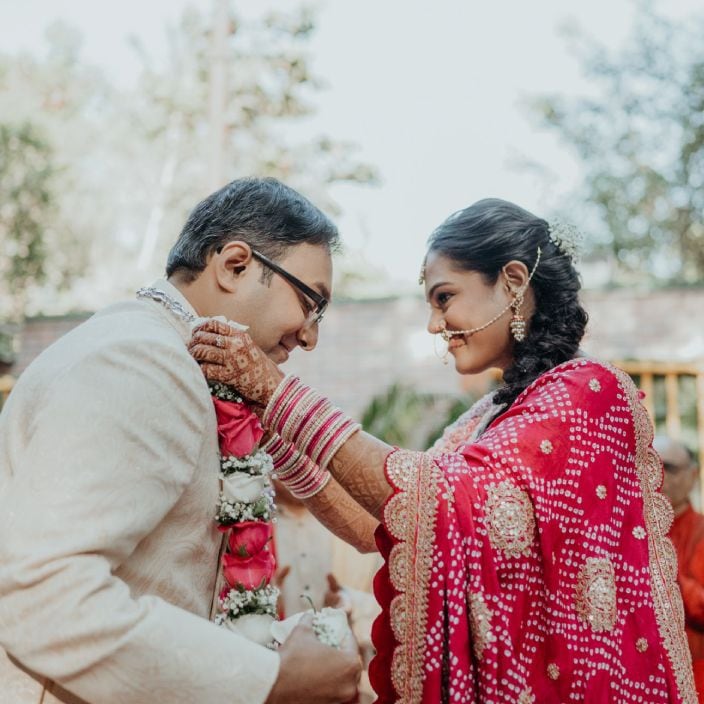For best prices and early deliveries, WhatsApp us at. 918488070070
Odisha
Weddings in Odisha are vibrant celebrations that weave together tradition, culture, and family values, reflecting the state's rich heritage. Known for their deep-rooted customs and colourful rituals, Odisha weddings are more than just a union of two individuals – they are a confluence of families, a celebration of community, and a tribute to the state’s diverse cultural tapestry. Each ritual, from the pre-wedding 'Nirbandh' (engagement) to 'Gruhaprabesa' (bride's entry into the groom’s house) and Asta Mangala (eight days of rituals), carries profound significance and symbolises the couple's journey toward a shared future. Odisha weddings are marked by a blend of simplicity and elegance, emphasising spiritual purity and familial blessings. Ancient Vedic traditions, regional folklore, and a deep reverence for the divine influence the rituals. The 'Kanyadaan' ceremony, where the bride is given away as a gift by her parents, and the 'Saptapadi,' or seven steps around the sacred fire, embody the promise of love and commitment. Unique ceremonies like 'Hata Ganthi' (tying the sacred knot) and 'Bahaghara' (the wedding ceremony) showcase the beauty of Odia wedding traditions. The 'Barajatri' (groom's procession), an event filled with music and merriment, is a highlight of the wedding day and the 'Laja Homa', where offerings of puffed rice are made to the sacred fire as a symbol of the bride’s prosperity and wishes for her new journey. Post-wedding customs such as 'Chauthi' (the fourth-day celebration) and 'Bahuna' (welcoming the bride’s family back) add depth and joy to the festivities. Fun-filled games like 'Kau?i Khe?a' (a traditional shell game) help the couple bond and bring a playful end to the wedding ceremonies. Steeped in age-old traditions yet accommodating modern touches, Odia weddings offer a unique glimpse into the cultural richness of Odisha. Let’s deep dive into them.
Tracing the Traditions
Odisha houses diverse wedding rituals that vary across its regions, reflecting its multi-ethnic charm. In coastal Odisha, weddings often feature a grand Barjatri, where the groom arrives on a beautifully adorned horse accompanied by music and dance. The Kanyadaan, or giving away of the bride, is a significant ritual where the bride’s parents place her hands in the groom’s, symbolising a spiritual union.
In the tribal regions, weddings are marked by unique customs deeply rooted in nature and folklore. For instance, the Dongria Kondh tribe has a Mandia Pitha (millet cake) ritual, where cakes are exchanged as a symbol of prosperity and fertility. Meanwhile, the Santal community performs the Jhenka Nacha, a lively dance involving the entire village, celebrating love and unity.
In western Odisha, the Chaurath ritual is popular, where the bride and groom exchange garlands, followed by a sacred thread ceremony to seek blessings from the divine. Each region in Odisha brings its distinct flavour to wedding celebrations, embodying the state’s vibrant cultural heritage. These varied rituals not only celebrate love but also pay homage to Odisha's rich traditions and communal harmony.
Wedding Attire
Brides in Odisha typically wear a stunning saree known as a Sambalpuri, Bomkai saree or Berhampuri Patta saree, woven in Khandua & Tussar silk or cotton, with intricate ikat or temple motifs that carry deep cultural significance. The sarees are often in shades of red, maroon, or gold, symbolising prosperity and auspiciousness.
Odisha brides adorn themselves with striking jewellery pieces like the Mathapatti (forehead band), Chandra Haar (moon-shaped necklace), Kaan (ear cuffs), and Baula Patra bangles. They also wear Shankha Pola (red and white bangles made from conch shells and coral), symbolising marital bliss.
The jewellery is usually crafted from gold and often features intricate filigree work, a hallmark of Odisha’s artistry. The bride’s hands and feet are decorated with Alata, a red dye used to create intricate patterns, adding a vibrant and festive touch to her look.
Grooms traditionally wear a Dhoti and Kurta or Sherwani, often made of silk or fine cotton. The attire is typically in neutral tones like white, cream, or beige, embellished with zari or simple embroidery. To complete the look, grooms wear a Pheta (turban) and sometimes a Kundal (earring), adding a regal touch.
Traditional Cuisine
Known for its distinct flavours and unique preparation, traditional Odia cuisine brings together sweet, savoury, and spicy dishes that appeal to every palate. Wedding feasts in Odisha, often referred to as Banquet Bhoji, are elaborate affairs where the guests are served an array of dishes on banana leaves.
Among the most popular dishes is the Pakhala Bhata, a fermented rice dish that is refreshing and considered auspicious. It is often complemented with Dalima, a unique dal preparation cooked with raw papaya and arhar lentils, and Besara, a tangy dish made with mixed vegetables and mustard paste. Sweet treats like Chhena Jalebi, Rasgulla, and Pitha varieties such as Manda Pitha and Arisa Pitha add richness to the celebratory feast.
Another highlight is Chenna Poda, a caramelised cheese dessert that melts in your mouth, leaving a lasting taste.
Meat lovers are in for a treat with Mansa Tarkari, a spicy goat curry cooked with freshly ground spices, and Machha Besara, a fish curry simmered in mustard and tomato gravy. The entire spread is balanced with an assortment of pickles, chutneys, and Kheeri, a sweet rice pudding that signifies happiness and prosperity.
Cultural Decor
Wedding decor in Odisha often features a delightful mix of local elements like pattachitra paintings, intricate appliqué work, and colourful jhoti-chita patterns drawn with rice paste.
Banana leaves, marigold flowers, and mango leaves are essential decor elements, symbolising purity, prosperity, and new beginnings. The 'Toran' at the entrance, made from green mango leaves, signifies a warm welcome to guests and blessings for the newlyweds.
The wedding mandap is traditionally adorned with 'Chandua' – handcrafted appliqué work from Pipili, Odisha's renowned artisan village. Vibrant canopies embroidered with mirrors and vivid threads hang gracefully, adding a festive charm. The flooring often features alpana or rangoli designs, incorporating rice flour and natural dyes.


